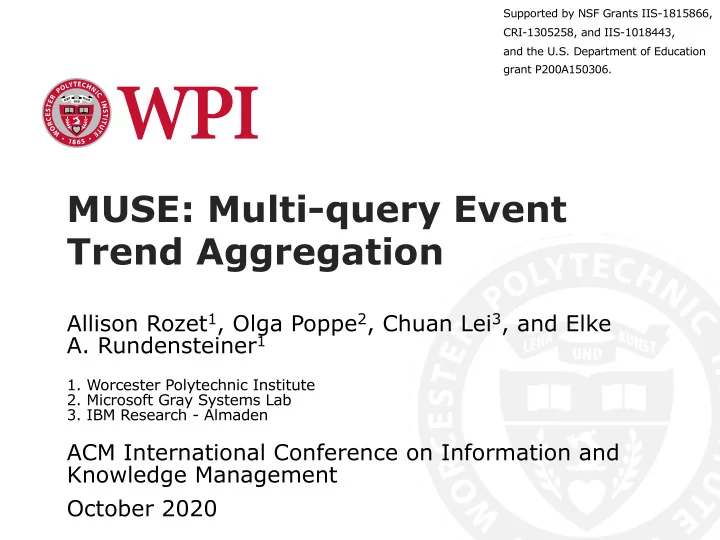

Supported by NSF Grants IIS-1815866, CRI-1305258, and IIS-1018443, and the U.S. Department of Education grant P200A150306. MUSE: Multi-query Event Trend Aggregation Allison Rozet 1 , Olga Poppe 2 , Chuan Lei 3 , and Elke A. Rundensteiner 1 1. Worcester Polytechnic Institute 2. Microsoft Gray Systems Lab 3. IBM Research - Almaden ACM International Conference on Information and Knowledge Management October 2020
Complex Event Processing 2 Primitive events Complex events CEP engine Input: High-rate, Output: Reliable summarized potentially unbounded insights about the current event stream situation in real time Worcester Polytechnic Institute Introduction MUSE Evaluation
Problem 3 Objective: Near Instantaneous Responsiveness Expensive Event Trend Aggregation Queries Our goal is to identify, analyze, and exploit sharing opportunities in order to optimize workload High Volume, processing. High Velocity Event Stream Worcester Polytechnic Institute Introduction MUSE Evaluation
Kleene Pattern Aggregation Query 4 Query q1: RETURN COUNT(*) A trend is an arbitrarily long PATTERN B+ sequence of events that matches the query. Stream: COUNT(*) returns the b1, b2, b3 number of trends. A two-step approach Trends: constructs all matches prior b1 to aggregation. b1, b2 b1, b2, b3 Exponential complexity. b1, b3 Final count: 7 b2 b2, b3 b3 Worcester Polytechnic Institute Introduction MUSE Evaluation
5 Online Aggregation Query q1: RETURN COUNT(*) An online approach maintains PATTERN B+ aggregates incrementally. Stream: bi.count is the number of b1, b2, b3 partial trends that end at event bi. For example, b3.count tells us Event bi.count that there are 4 partial trends b1 1 that end at b3. They are b2 2 (b1,b2,b3), (b1,b3), (b2,b3), and (b3). b3 4 Quadratic complexity. Final count: 7 Worcester Polytechnic Institute Introduction MUSE Evaluation
6 Multi-query Online Aggregation Query q1: Query q2: RETURN COUNT(*) RETURN COUNT(*) PATTERN B+ PATTERN SEQ(A,B+) We have an identical sub-pattern… Stream: Stream: b1, a1, b2, b3 b1, a1, b2, b3 Event bi.count Event ai.count bi.count b1 1 a1 1 …but the numbers b2 2 b2 1 are not the same. How could b3 4 b3 2 anything possibly be shared here? Final count: 7 Final count: 3 Worcester Polytechnic Institute Introduction MUSE Evaluation
Challenges 7 Sharing diverse nested Kleene patterns : SEQ(P, T+, D) SEQ(SEQ(P, T+)+, D) Shared computation without trend construction : Sharing requires Online skips trend trend construction construction Optimizing the Kleene sharing plan : Exponentially large search space Worcester Polytechnic Institute Introduction MUSE Evaluation
Muse* Executor 8 Non-shared execution Execution sharing B+ q1 = B+ MatPoint (materialization point) is B. q2 = SEQ(A,B+) A MatState (materialized state) q3 = SEQ(A,B+)+ stores each query’s intermediate trend aggregate. * Muse = Mu lti-query s hared e vent trend aggregation Worcester Polytechnic Institute Introduction MUSE Evaluation
Benefit Model 9 If Benefit(<E’,E>, Q) > 0, we say it is beneficial to share . Lemma 3.2. The more queries that share a sub- pattern, the more beneficial it becomes. Lemma 3.3. Reducing the number of MatStates increases the sharing benefit. Worcester Polytechnic Institute Introduction MUSE Evaluation
Muse Optimizer 10 • Begin with a global sharing plan • Prune plans in the search space using Lemmas 3.2 and 3.3 • Optimizer follows a modified topological sort algorithm Worcester Polytechnic Institute Introduction MUSE Evaluation
Experimental Setup 11 Data Sets : • NASDAQ Stock Market Real Data Set ─ Transactions for over 3200 companies for one month ─ Stock ticker symbol, time stamp, price, volume • Ridesharing Synthetic Data Set ─ Controls the rate of event types in the stream ─ 50 event types and 20 districts NASDAQ Stock Market Real Data Set. EODData, Historical Price Data. https://www.eoddata.com, 2019. Worcester Polytechnic Institute Introduction MUSE Evaluation
Experimental Results 12 Muse has a throughput gain of 3 orders of magnitude over Sharon • at 15k events per window (left: ridesharing) Muse outperforms MCEP by 4 orders of magnitude at 25k events • Muse achieves 14-fold increase in throughput over GRETA on a • higher-rate event stream (right: stock) Worcester Polytechnic Institute Introduction MUSE Evaluation
Experimental Results 13 Muse achieves from 7-fold to 25-fold throughput gain over GRETA • when the number of queries increases from 50 to 300 (left: stock) For streams with very few MatStates, Muse sees nearly 7-fold • increase in throughput compared to GRETA (right: ridesharing) Worcester Polytechnic Institute Introduction MUSE Evaluation
Conclusions 14 • Muse defines shared aggregation of event trends matched by diverse nested Kleene pattern queries over high speed streaming data in real-time • Several orders of magnitude performance improvement over state-of-the-art Worcester Polytechnic Institute
Recommend
More recommend